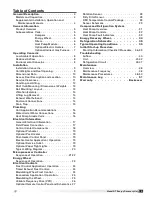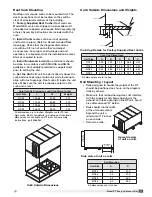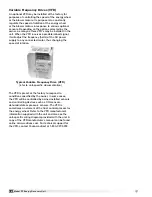
14
Model RT Energy Recovery Unit
The method of compressing and restraining the motor
/ blower assembly varies with each product. If sheet
metal screws or bolts are used, they are installed with
an equal number on both the front and the rear of
each assembly. Screws or bolts used on the rear rail
of the assembly are difficult to see. It is recommended
that the rear screws or bolts be removed prior to the
front ones in order to reduce the chance of injury. If
restraining bands are used instead of screws or bolts,
carefully cut and remove the bands.
Upon receipt, visually inspect motor / blower
assemblies to verify presence of spring isolation
devices. If they are present, carefully remove shipping
restraints to allow free movement of assembly.
NOTE
Many motor / blower assemblies include optional
spring vibration isolation devices. When these
isolation springs are used, the motor / blower
assembly is secured for shipment by compressing
the springs and securing the assembly to
intermediate rails (see photo).
CAUTION
These assemblies are shipped with the springs in
a compressed state and when shipping restraints
are removed, the assembly will bounce upward.
Do not position hands or fingers where they may
be pinched or injured by sudden movement of the
assembly.
Motor / Blower Assembly
in shipping position
Spring Isolation
Device
Vibration Isolators
Any lifting lug that is located as shown should be
removed in order to permit installation of the P trap
drain kit.
NOTE
On some models of the RT, one lifting lug may be
positioned directly in front of the condensate drain
connection. See illustration.
1 Fan
Wheel
Dia.
1 Fan
Wheel
Dia.
Rota
tio
n
Rota
tio
n
R
ot
ation
R
ot
ation
Length of Straight Duct
GOOD
POOR
GOOD
POOR
GOOD
POOR
Turning
Vanes
Turning
Vanes
SYSTEM EFFECT FACTOR CURVES
FPM X 100
OUTLET VELOCITY
0 5 10 15 20 25 30 35 40 45
1.2
1.0
0.8
0.6
0.4
0.2
0.0
S
TA
TIC PRESSURE LOSS
CUR
VE
1
CUR
VE
2
CUR
VE
3
CUR
VE 4
Recommended Discharge Duct Size and Length
Model
Blower
Size
Duct Size Straight Duct Length
RT-20
9
14 x 14
36
RT-45
10
20 x 20
36
RT-55
12
20 x 20
36
RT-90
15
28 x 28
60
All dimensions shown in inches.
• Recommended duct sizes are based on velocities across the
cfm range of each model at approximately 800 feet per minute
(FPM) at minimum airflow and up to 1600 fpm at maximum
airflow. Recommended duct sizes are only intended to be a
guide and may not satisfy the requirements of the project.
Refer to plans for appropriate job specific duct size and/or
velocity limitations.
• Straight duct lengths were calculated based on 100% effective
duct length requirements as prescribed in AMCA Publication
201. Calculated values have been rounded up to nearest foot.
Ductwork Connections
Examples of poor and good fan-to-duct connections
are shown below. Airflow out of the fan
should be directed straight or curve
the same direction as
the fan wheel rotates.
Poor duct installation
will result in low airflow
and other system
effects.
1 Fan
Wheel
Dia.
1 Fan
Wheel
Dia.
Rota
tio
n
Rota
tio
n
R
ot
ation
R
ot
ation
Length of Straight Duct
GOOD
POOR
GOOD
POOR
GOOD
POOR
Turning
Vanes
Turning
Vanes
SYSTEM EFFECT FACTOR CURVES
FPM X 100
OUTLET VELOCITY
0 5 10 15 20 25 30 35 40 45
1.2
1.0
0.8
0.6
0.4
0.2
0.0
S
TA
TIC PRESSURE LOSS
CUR
VE
1
CUR
VE
2
CUR
VE
3
CUR
VE 4
Exhaust Weatherhood
The exhaust weatherhood is shipped
separately as a kit with its own
instructions.
Intermediate
Shipping Rail
(typical)















































